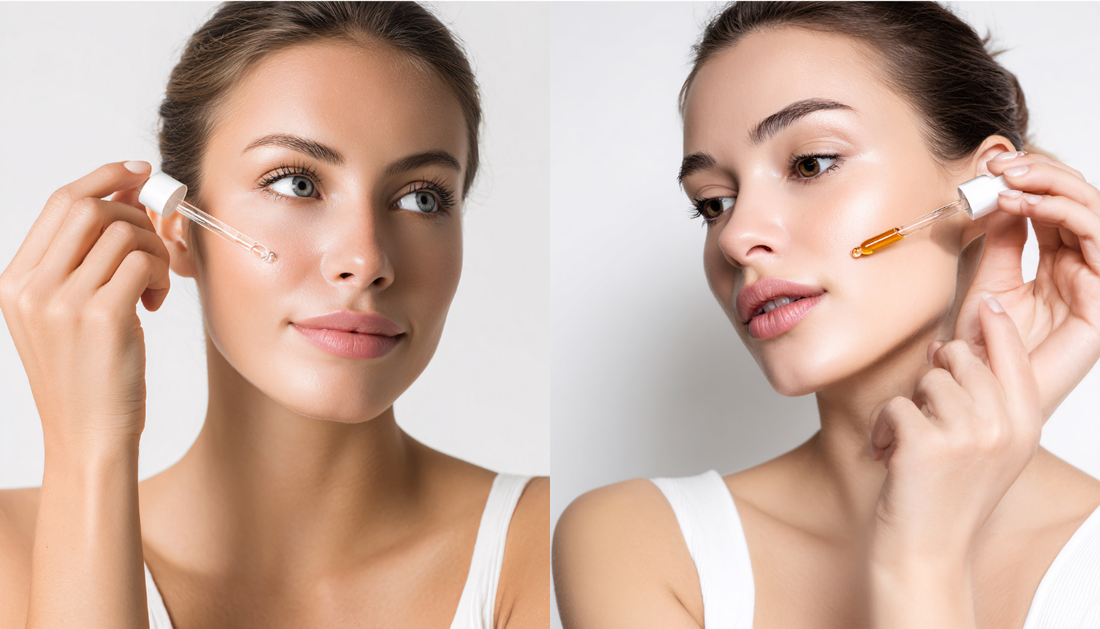
Niacinamide vs. Vitamin C: Which Brightening Ingredient Should You Choose?
This guide from Youthology offers a clear look at Niacinamide vs Vitamin C. Both are key in anti-aging and brightening skincare. They help achieve an even skin tone in different ways. Vitamin C skincare, like L-ascorbic acid, gives quick radiance and firming support.
Niacinamide benefits are great for daily use, providing calm clarity with fewer side effects. It's like a steady multitasker for your skin.
Vitamin C is a strong fighter against photodamage and stubborn spots. It needs careful formulas and packaging to stay effective. Niacinamide, on the other hand, supports the skin barrier, reduces redness, and controls oil levels, usually at 2%–5%.

For tackling hyperpigmentation, many dermatologists recommend using both. Start with what your skin can handle. Use vitamin C for a targeted glow and collagen boost. Use niacinamide for balance, comfort, and wide-ranging benefits. Together, they're among the top choices for a smoother tone and everyday skin resilience.
What Makes Niacinamide and Vitamin C Brightening Powerhouses
Vitamin C and niacinamide are top choices for brightening skin. They tackle dull skin in different ways. Together, they help fade dark spots and soften lines, as seen in Youthology.

How vitamin C fights free radicals and supports collagen
L-ascorbic acid fights off damage from sun and pollution. It protects skin lipids and reduces oxidative stress, leading to dark spots. It also boosts collagen, making skin smoother and more elastic. Used in daytime, it enhances sunscreen's effect.
Why niacinamide is a gentle, barrier-strengthening multitasker
Niacinamide reduces redness and balances oil. It strengthens the moisture barrier, making it great for sensitive skin. It also refines pores and brightens tone, even at low levels.
Its neutral pH makes it stable and easy to layer. It's a daily go-to in moisturizers and serums from Youthology.
Shared benefits: fade hyperpigmentation, improve wrinkles, even skin tone
Both ingredients tackle uneven tone and fine lines. They offer antioxidant defense and surface renewal. Regular use makes skin look even, smooth, and brighter.
They also fit well in routines that value comfort. This allows for combining their strengths without overtaxing the skin.
Key differences in potency, stability, and skin tolerance
Vitamin C acts quickly on spots but needs specific conditions to stay potent. It can cause tingling or flushing in some. Niacinamide is more stable, tolerated by most, and effective at lower doses.
The choice often depends on desired speed and comfort. Vitamin C offers quick results, while niacinamide provides steady improvement. Mixing both, as in Youthology routines, often leads to better results.
Niacinamide: Benefits, Ideal Skin Types, and Product Formats
Niacinamide works steadily without causing drama. It helps keep your skin bright and calm. It's a great start for anyone looking to brighten their skin routine.

Niacinamide benefits: brightening, oil regulation, pore appearance, redness relief
Niacinamide makes your skin tone even and texture smooth. It helps fade dark spots and brightens your skin. It stops pigment transfer.
It also controls oil, which can make pores look better over time. As your skin's barrier gets stronger, redness goes down. This makes your skin clearer and more balanced.
Niacinamide for sensitive skin and skincare for dull skin
Niacinamide is good for sensitive skin because it's gentle. It's perfect for those who often get dry or have flare-ups.
It's also great for dull skin by making it clearer and brighter. Using it with a gentle cleanser keeps your skin soft without feeling tight.
Effective ranges: why 2%–5% is often enough for results
Most people see changes with 2%–5% niacinamide. This range improves tone, oil balance, and texture without irritation.
Higher strengths might cause flushing in some. Start with 2%–5% and use it every day before trying stronger formulas.
Where it fits: brightening toner with niacinamide, moisturizers, serums, sunscreens
A brightening toner with niacinamide is a simple first step after cleansing. Serums add extra punch, while moisturizers keep your skin hydrated and comfortable.
Sunscreen with niacinamide protects your skin during the day. Youthology recommends using it daily for the best results in your skincare routine.
| Format | Primary Role | When to Use | Pairs Well With | Who Benefits Most |
|---|---|---|---|---|
| Brightening toner with niacinamide | Kickstart tone-evening; prep skin | AM/PM after a clarifying facial cleanser with amino acids | Hydrating serums, lightweight moisturizers | Skincare for dull skin; combination types |
| Serum (2%–5%) | Targeted niacinamide for brightening and oil control | AM/PM on clean, dry skin | Hyaluronic acid, panthenol, ceramides | Oily, acne-prone, and sensitive users |
| Moisturizer with niacinamide | Barrier support and redness relief | AM/PM after serum | Soothing ingredients; mineral sunscreen | Skincare for sensitive skin; dryness-prone |
| Sunscreen with niacinamide | UV defense to preserve tone gains | AM, last step | Antioxidants; gentle cleansers | All skin types focused on long-term results |
| Cleanser (amino-acid based) | Soft cleanse to protect barrier | AM/PM first step | Brightening toner with niacinamide; serum | Reactive, tight-feeling, or over-exfoliated skin |
Vitamin C: Science-Backed Brightening and Anti-Aging Skincare
Dermatology labs and estheticians choose vitamin C skincare for a reason. It tackles tone, texture, and aging in one go. When picked right, it's a top choice for brightening and daily defense.
Pro tip: Apply on clean, dry skin before moisturizer and sunscreen. This ensures consistent results for fading hyperpigmentation.
Vitamin C for dark spots and how to fade hyperpigmentation
Vitamin C for dark spots stops excess pigment and reduces stress. Regular use evens tone and boosts radiance. For fading hyperpigmentation, use a daily serum with consistent routines.
Brand like Youthology offer formulas for stubborn marks. Their vitamin C lines aim for clarity while soothing the skin.
Potency and stability: L-ascorbic acid, pH considerations, light/air protection
L-ascorbic acid is the top choice. Dermatologists prefer water-based serums at 10%–20% with a low pH. This ensures better absorption. Dark, airtight, or airless bottles protect against oxidation.
If your skin is sensitive, try mid-strength options or stabilized forms. Fresh, sealed bottles are essential to prevent degradation from air and light.
Vitamin C anti-aging: collagen support and photoaging markers
Vitamin C helps support collagen, reducing fine lines. Regular use improves photoaging signs like dullness and uneven tone. Skin becomes smoother and more resilient over time.
It's like daily maintenance that refines texture and boosts your routine's results.
Daytime synergy: pairing with hydrated sun protection SPF50+
For daytime, apply an antioxidant serum under SPF50+ for extra protection. This combo prevents new spots and maintains hyperpigmentation gains.
Start with vitamin C, then moisturizer if needed, and finish with sunscreen. This combination fades hyperpigmentation while keeping benefits locked in, as Youthology recommends.
Niacinamide vs Vitamin C, Brightening ingredients comparison
Choosing between niacinamide and vitamin C depends on your skin goals and how your skin reacts. For a balanced skincare routine, match the strength and texture of these ingredients to your needs. Youthology suggests focusing on what works best for you, not just the latest trend.
Which to choose for sensitivity, oiliness, or acne-prone concerns
For sensitive skin, start with niacinamide. It helps reduce redness, strengthens the skin barrier, and controls oil. This makes it great for acne-prone skin.
If you have normal to oily skin and want a simple skincare upgrade, niacinamide is a good choice. It helps even out your skin tone and makes pores look smaller. Remember to use sunscreen daily to keep your results going.
When vitamin C may outperform for stubborn discoloration
For dark spots that won't go away, vitamin C is the better choice. Use a high-quality, stable vitamin C formula every morning. It targets dark spots and protects your skin from damage.
When used with sunscreen, vitamin C helps with hyperpigmentation on sun-exposed areas. People often see their skin brighten up faster if they already use other skincare products.
Texture, tolerance, and formulation reliability: easy niacinamide vs finicky vitamin C
Niacinamide is easy to use. It works well in serums, moisturizers, and sunscreens, without needing a specific pH level. It's stable over time, making it easy to add to your routine.
Vitamin C, on the other hand, can be tricky. It needs a low pH and must be stored in an airtight container. Some people might experience tingling or dryness. But, for those who can tolerate it, vitamin C can really help with aging and dark spots.
Results timeline: targeted potency vs steady, gentle improvement
Vitamin C works fast on dark spots and uneven skin tone. Its antioxidant properties help smooth out photo-damaged skin.
Niacinamide, on the other hand, offers gradual improvements. It helps with texture, oil balance, and reduces blotchiness. When choosing between niacinamide and vitamin C, think of them as part of a balanced skincare plan. They work together to improve your skin over time.Can You Use Niacinamide and Vitamin C Together?
Yes, dermatologists say you can mix niacinamide and vitamin C. Vitamin C brightens and boosts collagen. Niacinamide calms, balances oil, and strengthens the skin. Together, they create a smooth, radiant look.
How to layer for results: Start with vitamin C serum on clean skin in the morning. Then, add a niacinamide serum or moisturizer. Finish with SPF50+ to keep your skin safe and bright.
For a simple routine, cleanse, apply vitamin C, then niacinamide moisturizer or toner. Use a product like glaze glowthe diamond toner for a light, shiny finish. Sunscreen comes last to protect your skin.
If your skin is sensitive, start with niacinamide on alternate days. Watch for any irritation from vitamin C. Niacinamide's calming effect helps you build up to using both products.
| Step | AM Routine Focus | Why It Helps | Notes |
|---|---|---|---|
| 1 | Cleanse | Removes oil and impurities for better absorption | Pat skin fully dry before vitamin C |
| 2 | Vitamin C Serum | Targets dullness and supports collagen | Apply thin layer first in a brightening skincare routine |
| 3 | Niacinamide Layer | Soothes, refines look of pores, balances oil | Use serum or moisturizer; fits the niacinamide vs vitamin c pairing |
| 4 | Toning Option | Light hydration and extra radiance | Try glaze glowthe diamond toner as a diamond toner for glowing skin |
| 5 | SPF | Shields gains and helps prevent new spots | Finish with hydrated sun protection spf50+; Youthology favors daily use |
Conclusion
The debate between Niacinamide and Vitamin C isn't about who wins. Vitamin C is a strong antioxidant that boosts collagen and fights dark spots. It's best used in the morning with SPF.
Niacinamide offers steady results. It balances oil, reduces redness, and strengthens the skin. It's great for sensitive skin and those with acne or oily skin.
Choose based on what you want. For quick brightening and anti-aging, use a vitamin C serum with SPF. For a calm, gradual effect, go with niacinamide at 2%–5%.
Many find the best approach is to use both. Apply vitamin C in the morning and niacinamide in the same or alternate routines. This combo builds resilience and radiance.
From a Youthology view, follow the science. Cleanse, apply vitamin C, moisturize, and protect. Use niacinamide to soothe and even out your skin tone. This plan leads to a calm, clear glow over time.
FAQ
What’s the main difference between niacinamide and vitamin C for brightening?
Vitamin C is a strong antioxidant that fights dark spots and boosts collagen. This helps brighten and anti-age your skin fast. Niacinamide, on the other hand, is a gentle multitasker. It calms redness, balances oil, and improves skin tone over time. Most people use both for the best results.
Is vitamin C or niacinamide better for sensitive skin?
Niacinamide is usually better for sensitive skin. It works well at 2%–5% and is gentle. Vitamin C can sting at high strengths, but many people tolerate it. Start slow if you're sensitive.
How does vitamin C fight free radicals and support collagen?
Vitamin C fights UV and pollution damage that causes aging. It also helps make collagen, which smooths lines and firms skin. Use it in the morning under SPF for extra protection.
Why is niacinamide considered a gentle, barrier-strengthening multitasker?
Niacinamide is anti-inflammatory and strengthens the skin barrier. It reduces redness and water loss. It also controls oil, refines pores, and evens skin tone. Its stability makes it versatile for many products.
What shared benefits do niacinamide and vitamin C offer?
Both brighten dull skin and fade dark spots. They also improve fine lines and texture. Using both consistently can lead to a healthier, more even complexion.
How do potency, stability, and tolerance differ between the two?
Vitamin C is more potent but tricky to use. It needs a low pH and water-based serum. Niacinamide is stable, effective at 2%–5%, and easy to use daily.
What are the key niacinamide benefits for everyday skin concerns?
Niacinamide brightens dark spots, controls oil, reduces redness, and improves texture. It's great for sensitive skin, rosacea, and oily or acne-prone skin.
What concentration of niacinamide works best?
Effective ranges are 2%–5%. This range offers visible improvements with low irritation. Higher percentages can cause flushing in some.
Where does niacinamide fit in a routine, and what formats are best?
Niacinamide works well in toners, serums, moisturizers, and sunscreens. Start with a gentle cleanser before using niacinamide. Use it AM and PM for best results.
How does vitamin C help fade dark spots and hyperpigmentation?
Vitamin C targets the causes of dark spots, reducing them and improving skin radiance. Daily SPF helps prevent new spots and maintain results.
What should I know about vitamin C’s potency and stability?
The best vitamin C is L-ascorbic acid in a water-based serum at low pH. Effective ranges are 8%–20%. Use dark glass or airtight packaging to keep it fresh.
In what ways does vitamin C deliver anti-aging benefits?
Vitamin C supports collagen, smoothing lines and firming skin. It brightens photoaged skin. Regular use improves texture, tone, and signs of aging.
Why pair vitamin C with hydrated sun protection SPF50+ during the day?
Vitamin C adds antioxidant defense, while SPF blocks UV damage. This duo maintains brightening and protects against future damage.
Which should I choose for sensitivity, oiliness, or acne-prone skin?
For sensitivity, redness, or oil control, start with niacinamide. It's gentle and effective. If your skin is resilient, vitamin C is strong for brightening. Many use both for balanced results.
When might vitamin C outperform niacinamide for stubborn discoloration?
For deep dark spots and photodamage, vitamin C acts faster. Pair it with SPF to prevent new spots and maintain results. Add niacinamide for ongoing clarity.
How do texture and formulation reliability compare?
Niacinamide is versatile and stable across products. Vitamin C is more finicky, needing low pH and protective packaging. Poor formulation can weaken results.
What results timeline should I expect from each?
Vitamin C offers quick brightening and texture improvements. Niacinamide provides steady, gentle improvements. Combining them offers both quick and long-term benefits.
Can I use niacinamide and vitamin C together in one routine?
Yes. They complement each other. Apply vitamin C first, then niacinamide. Finish with SPF. This pairing enhances brightening and boosts collagen.
What’s an easy brightening skincare routine to start with?
Morning: cleanse, vitamin C serum, niacinamide hydrator or toner, then SPF50+. Evening: cleanse, niacinamide serum or moisturizer, and hydration. For extra glow, use a diamond toner before your serum.
Are there risks to using high percentages of either ingredient?
High-strength vitamin C can sting or dry out sensitive skin. High niacinamide may cause flushing in some. Start with proven ranges and adjust as needed.
Do niacinamide and vitamin C work for all skin tones and types?
Yes. Both work across skin tones and types. Vitamin C brightens and anti-ages most effectively. Niacinamide is gentle and effective for many skin concerns.
How do I prevent oxidation or reduced efficacy with vitamin C?
Use airless or dark packaging, store away from heat and light, and use within the recommended period. A fresh, water-like serum texture and light color indicate stability. If it turns dark or smells off, it's oxidized.
What other brightening ingredients pair well with these?
Azelaic acid, arbutin, kojic acid, licorice root, and exfoliating acids like mandelic or lactic work well with vitamin C and niacinamide. Always prioritize barrier health and daily SPF for sustained results.

